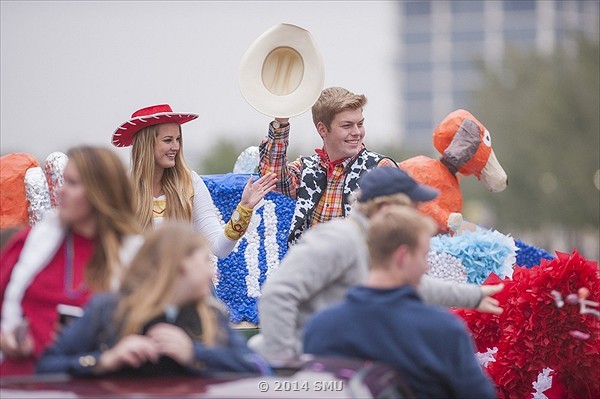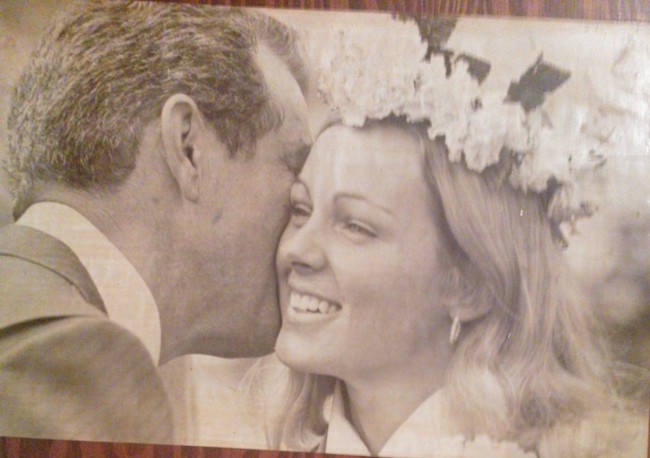
For more than a century, several traditions have endured the test of time on SMU’s campus. From Peruna to Pigskin Revue, parades to crownings, Homecoming has left its mark as the grandest celebration of SMU spirit.
The time-honored tradition began in the spring of 1920; five years after the university opened its doors to 456 students and 37 faculty members. Then, the celebrations looked different, as alumni barbecues and school-wide dances were the main events outside of the football games.
In 1923, Homecoming moved to Thanksgiving Day where it remained for several years. During this time students and alumni participated in traditional events, like luncheons and the parade, but they also started their own unique ones as well.
One of these short-lived traditions was a school-wide bonfire in 1934. The flames only burned for 20 years until the bonfire tradition was abolished after SMU’s 50th anniversary in 1954.
However, throughout its history, two elements of Homecoming have remained constant: the crowning of SMU Homecoming Queens and the Mustang Band.
Valerie Dunnam (’53) remembers the 1953 Homecoming well. It was the year she was chosen out of 13 candidates and named Homecoming Queen.
“We were interviewed by a secret committee selected by the alumni association,” Dunnam said. “The winner was kept secret until Game Day.”
According to Dunnam, the 1953 Homecoming activities consisted of a luncheon, alumni picnic at Fair Park, the Pigskin Revue, float decorating, a parade and a Homecoming Dance at the Science Museum.
The major difference between the 1953 Homecoming and today was the campus life. The culture was more conservative as students had to adhere to a curfew; however, the drinking age was 18 and smoking was generally accepted.
“We enjoyed our college days, but also studied hard,” Dunnam said. “It was a happy and less complicated time than the 1960s and later decades.”
Beverly Hammond (’71) experienced a similar culture of campus life. Hammond recalled that dorms were not co-ed and students still had curfews of 10:30 p.m. on weeknights and midnight on weekends. But students were embracing the climate of the ’70s though with their attire.
“We were wearing bell-bottom pants, crop-tops and tie dye fabrics,” Hammond said.
Hammond said she was wearing knee-high gray suede boots, a pink velvet jacket and a short white-pleated skirt when she was crowned Homecoming Queen in 1971.
“Then sororities always nominated their president as their candidate. I was not the president so I was nominated by SAE as I was one of their Little Sisters of Minervas,” Hammond said.
Hammond believes SAE’s nomination and her engagement to SMU Quarterback Gary Hammond helped her win. She still cherishes the moment to represent SMU as the 1971 Homecoming Queen.

“It was an opportunity to promote my school and to give to the community,” she said. “I think the entire experience was a blessing.”
Twelve years, and several football wins later, Suzanne Hébert Everbach (’83) was crowned Homecoming Queen. It was a time when SMU football reigned supreme and SMU had the winningest football team in its history.
“I was very close to the athletics scene in 1983 as I was an SMU cheerleader and my mom was the SMU Athletic Director’s Administrative Assistant,” Everbach said.
Because of this, Everbach was thrilled when she was named Homecoming Queen in 1983.
“It was a cherished moment of my lifetime,” Everbach said. “I was one of a field of young ladies with whom I felt so deeply privileged to be amongst.”
Shortly after Everbach was crowned, SMU received the Death Penalty in 1987 and Homecoming became centered around a soccer match or swim meet, according to an Oct. 29, 1989 issue of the Dallas Times Herald.
Homecoming in the 1990s was centered around increasing student involvement with funding for Homecoming floats, creating a Homecoming concert and allowing students to bring alcohol to campus in 1995.
But throughout these changing times, the Mustang Band continued playing its traditional tunes.

According to Tommy Tucker, assistant director of Mustang Band, the band wore traditional military-style uniforms at events and games from 1917 to 1958 when Irving Dreibrodt arrived.
“He began altering the band’s look, moving to what we still wear: blazers, slacks, shirt and tie,” Tucker said.
‘The Best Dressed Band in the Land’ has consistently participated in the Homecoming parade and game and Pigskin Revue.
“The first Pigskin Revue was held in 1933, and to my knowledge, it has been part of Homecoming at SMU ever since then,” Tucker said.
According to Tucker, the framework for the show has essentially remained unchanged. Tucker has written music for every Pigskin Revue since 1981.
“The band plays several featured numbers, and students and alumni perform various skits and songs,” Tucker said. “All the music for the Revue is either pulled form the band’s files or written for that particular show.”
This year the tradition of Pigskin Revue will remain the same as SMU commemorates 100 years of academic life and celebrates 95 years of Homecoming fanfare.








